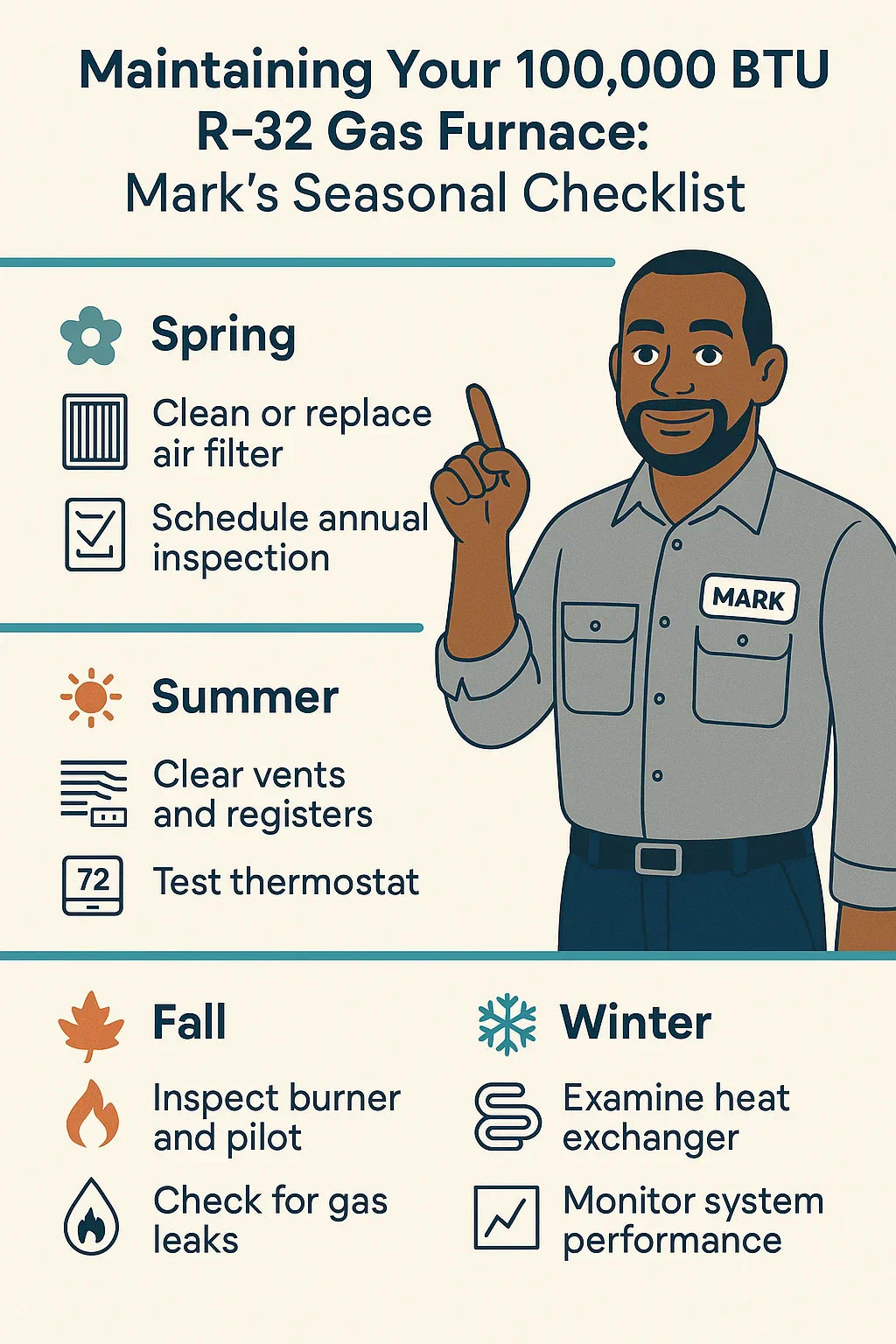1. 🔍 Why Seasonal Maintenance Pays Off
When I bought my 100,000 BTU R-32-compatible gas furnace, I thought I could “set it and forget it.”
That’s until I almost had a mid-winter breakdown because of a cracked igniter—caught just in time during a fall tune-up.
Here’s what I’ve learned:
-
Seasonal maintenance keeps your furnace running at peak efficiency.
-
For R-32-compatible systems, it’s even more important, since your AC or heat pump shares components like the evaporator coil.
-
Skipping maintenance can lead to higher energy bills, safety risks, and costly repairs.
“It’s like getting your car oil changed—you can put it off, but you’ll pay for it later.”
2. ❄ Winter – Peak Heating Season
During winter, your furnace works hardest. This is when daily reliability matters most.
Mark’s Winter Checklist:
-
Check filter monthly and replace if dirty.
-
Dirty filters restrict airflow, making your furnace work harder and wasting gas (EnergyStar Filter Tips).
-
-
Listen for new noises (whistling, banging, or rumbling).
-
Could indicate duct leaks, loose panels, or blower issues.
-
-
Check carbon monoxide (CO) detectors weekly.
-
Furnaces produce combustion gases—CO leaks can be deadly
-
-
Monitor your gas bill for sudden spikes.
-
May indicate declining efficiency or gas leaks.
-
Pro Tip: If your furnace short cycles (turns on/off rapidly), it may be a thermostat issue, clogged filter, or oversized unit.
3. 🌱 Spring – Transition to Cooling Mode
Spring is the perfect time to recover from winter wear and prepare for AC season.
Mark’s Spring Checklist:
-
Full post-winter inspection (by a pro if possible).
-
Includes checking burners, heat exchanger, and safety switches.
-
-
Clean blower motor and housing.
-
Dust buildup reduces efficiency and airflow.
-
-
Inspect & clean R-32 coil (if paired with AC/heat pump).
-
A dirty coil lowers cooling performance (DOE Coil Cleaning Guide).
-
-
Seal duct leaks.
-
Save up to 20% on heating/cooling costs (Energy.gov Duct Sealing).
-
4. ☀ Summer – Off-Season Furnace Care
Even in summer, your furnace matters—especially if it houses the blower for your R-32 AC.
Mark’s Summer Checklist:
-
Keep furnace area clear.
-
Store chemicals, paint, and flammable items elsewhere.
-
-
Check condensate drains (for high-efficiency models).
-
Prevents mold and water damage.
-
-
Inspect R-32 refrigerant lines.
-
Look for signs of wear, insulation damage, or corrosion
-
-
Test thermostat calibration.
-
Ensures accurate temperature control for both heating and cooling.
-
5. 🍂 Fall – Preparing for Heating Season
Fall is tune-up season—don’t wait until the first cold night to discover issues.
Mark’s Fall Checklist:
-
Professional tune-up & safety inspection.
-
Many manufacturers require annual service for warranty validity.
-
-
Test ignition system and burners.
-
Clean or replace as needed.
-
-
Lubricate moving parts.
-
Reduces motor wear.
-
-
Verify venting & flue.
-
Ensures safe exhaust of combustion gases.
-
My HVAC tech uses a combustion analyzer to fine-tune fuel-air mix for maximum efficiency—worth the cost.
6. 🛠 R-32 Specific Maintenance Tips
R-32 is an A2L refrigerant—mildly flammable and highly efficient. Even though your gas furnace doesn’t circulate refrigerant, its cooling coil may.
Maintenance musts:
-
Leak detection with proper sensors
-
Charge checks every 2–3 years for cooling performance.
-
R-32 certified technicians only
7. 📋 Mark’s Yearly Maintenance Budget
| Task | DIY Cost | Pro Cost |
|---|---|---|
| Filter replacement (4x/year) | $40–$80 | N/A |
| Annual tune-up | N/A | $120–$200 |
| Coil cleaning | $20–$40 | $100–$250 |
| Duct sealing | $50–$150 | $500–$1,500 |
| Total yearly average | ~$110 | ~$720 |
8. 📊 Common Maintenance Mistakes to Avoid
-
Neglecting coil cleaning – Can reduce cooling efficiency by 15%.
-
Skipping fall tune-up – Leads to mid-winter failures.
-
Wrong filter size/MERV – Too restrictive = strain on blower.
-
DIY refrigerant work – Illegal without certification and dangerous for A2L refrigerants.
Mark’s Final Word:
“Maintenance is cheaper than repair. If you follow a seasonal checklist, you’ll get better comfort, lower bills, and peace of mind—especially with R-32 systems that require extra attention to refrigerant safety.”
In the next topic we will read more about: How Well Do R-32 Gas Furnaces Perform in Cold Climates? Real-World Winter Heating Tests







